Analysis of Local Exergy Losses in Combustion Systems Using a Hybrid Filtered Eulerian Stochastic Field Coupled with Detailed Chemistry Tabulation: Cases of Flames D and E
Abstract
:1. Introduction
| Authors | Simulation | Fuel, Fuel Mixture | Configuration and Working Parameters | Main Outcomes |
|---|---|---|---|---|
| Safari, M. et al. [12] | Three-dimensional numerical | Methane | Non-premixed flame | Heat transfer and chemical reaction are the main culprits of EG |
| Nishida, K. et al. [1] | Three-dimensional numerical | Methane/hydrogen | Non-premixed and premixed flames | Heat transfer is the major source of EG in diffusion flame |
| Jejurkar and Mishra [18] | Three-dimensional numerical | Hydrogen | Multi-step kinetics on annular combustor | EG rate rises from lean to rich mixture (0.5 < Φ < 1.4) |
| Wenming et al. [19] | Numerical and experimental | Hydrogen | Gap length of block insert | Combustor with a gap length of 4 mm causes the lowest EG rate. Higher gap length results in higher EG |
| Morsli et al. [20] | Two-dimensional numerical | Propane | Oxygen percentage in air, equivalence ratio and inlet velocity | Thermal effect provides the main contribution to the total EG |
| Safer et al. [21] | Numerical | Hydrogen/carbon monoxide | Counterflow flames of syngas mixtures | Total volumetric EG decreases with hydrogen enrichment |
| Mohammadi and Ajam [22] | Two-dimensional numerical | Methane | Multi-step mechanisms and variable porosity of porous media | Heat transfer has the highest contribution in EG rate |
| Zuo et al. [23] | Three-dimensional numerical | Hydrogen | Mass flow rate, equivalence ratio, materials and inlet/outlet diameter ratios of variant diameter chambers | Modified microreactor features lower total EG compared to the old microreactor |
| Ni et al. [24] | Three-dimensional numerical | Hydrogen | Axial location and height of geometric shape ribs | Chemical reaction and conduction heat transfer contribute up to 70% and 15% of the total EG, respectively |
| Ansari and Amani [25] | Three-dimensional numerical | Methane | Flame stability, efficiencies and emission on combined baffle-bluff | In both combustion and MTPV efficiency, the EG rate is reduced by increasing the solid wall conductivity |
| Wang et al. [26] | Numerical | Methane/hydrogen addition | Flow velocity and H2 addition in a micro-planar combustor | EG rate induced by chemical reaction, mass diffusion and heat conduction rises with the flow velocity |
| Prashant et al. [27] | One-dimensional numerical | Hydrogen | Wall permeability, fuel–air ratio and unburnt mixture temperature | Fuel permeation through the wall tends to decrease the EG per unit of converted fuel |
2. Modeling Approach
2.1. The LES Hybrid ESF/FGM Approach
2.1.1. LES Description and FGM Tabulated-Chemistry-Based Combustion Model
2.1.2. The Eulerian Stochastic Field (ESF) Approach
2.1.3. Numerical Implementation
2.2. Exergy Analysis of Turbulent Reacting Flow
2.2.1. Thermodynamic-Based Approach
2.2.2. Turbulence-Based Approach
2.2.3. Look-Up-Table-Based Approach
3. Case Studies: Flames D and E
3.1. Case Description
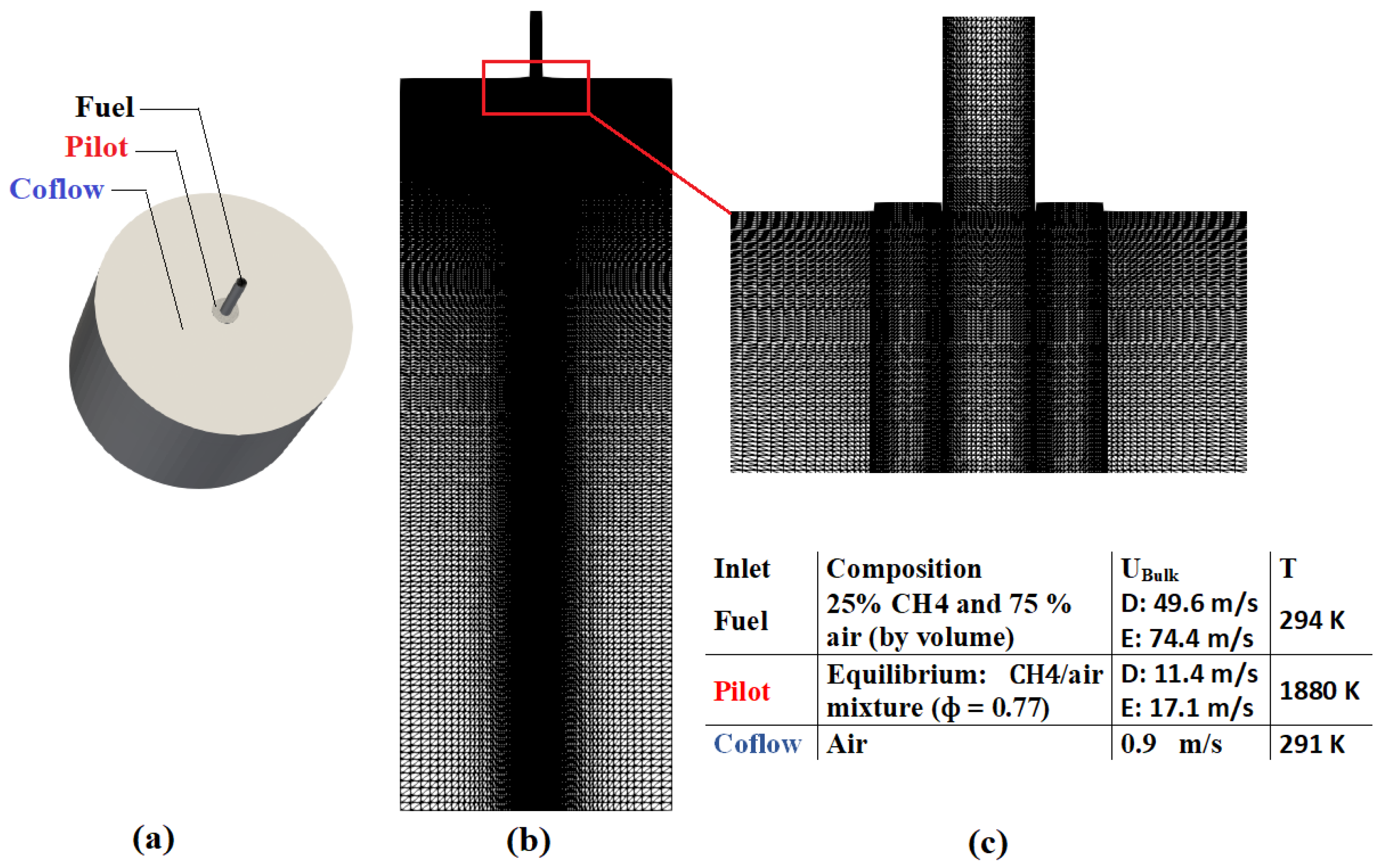
3.2. Case Validation
4. Exergy Analysis: Results and Discussions
5. Conclusions
- Good agreements are observed between the results obtained by using the two novel approaches suggested in the present paper and those reported in the literature for the mean entropy production rates and distribution in the case of flame D.
- The effect of the mass flow rate along with the Re number on the entropy production rates has been pointed out from the analysis performed for flame E in comparison to the reference, flame D. In particular:
- A peak of entropy generation is detected at the axial position close to the fuel nozzle for all the entropy generation terms.
- The radial profile of the entropy generation highlights the decrease in entropy downstream; the peaks vanish, except for entropy production due to the chemical reaction, in which a new peak is observed.
- The entropy generation contributions due to the heat transfer and chemical reaction processes dominate those due to diffusion and viscous dissipation.
- The entropy generation rates augment from flame D to flame E. This is explained by the increase in temperature, velocity and concentration gradients induced by a high mass flow rate associated with flame E.
- The computational cost appears to be less once the entropy generation analysis is performed by using the LES hybrid ESF/FGM approach together with the look-up-table-based or the turbulence-based approach.
Author Contributions
Funding
Data Availability Statement
Acknowledgments
Conflicts of Interest
References
- Nishida, K.; Takagi, T.; Kinoshita, S. Analysis of entropy generation and exergy loss during combustion. Proc. Comb. Inst. 2002, 29, 869–874. [Google Scholar] [CrossRef]
- Keenan, J.G. Availability and irreversibility in thermodynamics. Brit. J. Appl. Phys. 1951, 2, 183–192. [Google Scholar] [CrossRef]
- Bejan, A. Fundamentals of exergy analysis, entropy generation minimization, and the generation of flow architecture. Int. J. Energy Res. 2002, 26, 545–565. [Google Scholar] [CrossRef]
- Som, S.K.; Datta, A. Thermodynamic irreversibilities and exergy balance in combustion processes. Prog. Energ. Combust. 2008, 34, 351–376. [Google Scholar] [CrossRef]
- Sciacovelli, A.; Verda, V.; Sciubba, E. Entropy generation analysis as a design tool—A review. Renew. Sust. Energ. Rev. 2015, 43, 1167–1181. [Google Scholar] [CrossRef]
- Hirschefelder, J.O.; Curtiss, C.F.; Bird, R.B. Molecular Theory of Gases and Liquids; Wiley: Hoboken, NJ, USA, 1954. [Google Scholar]
- Ries, F.; Li, Y.; Klingenberg, D.; Nishad, K.; Janicka, J.; Sadiki, A. Near-wall thermal processes in an inclined impinging jet: Analysis of heat transport and entropy generation mechanisms. Energies 2018, 11, 1354. [Google Scholar] [CrossRef] [Green Version]
- Ries, F.; Li, Y.; Nishad, K.; Janicka, J.; Sadiki, A. Entropy generation analysis and thermodynamic optimization of jet impinge-ment cooling using large eddy simulation. Entropy 2019, 19, 129. [Google Scholar] [CrossRef] [Green Version]
- Ziefuss, M.; Karimi, N.; Ries, F.; Sadiki, A.; Mehdizadeh, A. Entropy generation assessment for wall-bounded turbulent shear flows based on Reynolds analogy assumptions. Entropy 2019, 21, 1157. [Google Scholar] [CrossRef] [Green Version]
- Ries, F.; Kütemeier, D.; Li, Y.; Nishad, K.; Sadiki, A. Effect chain analysis of supercritical fuel disintegration processes using an Les-based entropy generation analysis. Combust. Sci. Technol. 2020, 192, 2171–2188. [Google Scholar] [CrossRef]
- Safari, M.; Sheikhi, M.R.H.; Janbozorgi, M.; Metghalchi, H.; Sheikhi, R.H. Entropy transport equation in large eddy simulation for exergy analysis of turbulent combustion systems. Entropy 2010, 12, 434. [Google Scholar] [CrossRef]
- Safari, M.; Hadi, F.; Sheikhi, M.R.H. Progress in the Prediction of entropy generation in turbulent reacting flows using large eddy simulation. Entropy 2014, 16, 5159–5177. [Google Scholar] [CrossRef] [Green Version]
- Pope, S. PDF methods for turbulent reactive flows. Prog. Energy Combust. Sci. 1985, 11, 119–192. [Google Scholar] [CrossRef]
- Pope, S.B. A monte carlo method for the PDF equations of turbulent reactive flow. Combust. Sci. Technol. 1981, 25, 159–174. [Google Scholar] [CrossRef]
- Prasad, V.N. Large Eddy Simulation of Partially Premixed Turbulent Combustion. Ph.D. Thesis, Imperial College London, University of London, London, UK, 2011. [Google Scholar]
- Jones, W.; Prasad, V. Large eddy simulation of the Sandia flame series (D–F) using the Eulerian stochastic field method. Combust. Flame 2010, 157, 1621–1636. [Google Scholar] [CrossRef]
- Yifan, D.U.A.N.; Zhixun, X.I.A.; Likun, M.A.; Zhenbing, L.U.O.; Huang, X.; Xiong, D.E.N.G. LES of the Sandia flame series D-F using the Eulerian stochastic field method coupled with tabulated chemistry. Chin. J. Aeronaut. 2020, 33, 116–133. [Google Scholar]
- Jejurkar, S.Y.; Mishra, D.P. Numerical analysis of entropy generation in a annular micro combustor using multistep kinetics. Appl. Therm. Eng. 2013, 52, 394–401. [Google Scholar] [CrossRef]
- Wenming, Y.; Dongyue, J.; Kenny, C.K.Y.; Dan, Z.; Jianfeng, P. Combustion process and entropy generation in a novel micro combustor with a block insert. J. Chem. Eng. 2015, 274, 231–237. [Google Scholar] [CrossRef]
- Morsli, S.; Sabeur, A.; El Ganaoui, M.; Ramenah, H. Computational simulation of entropy generation in a combustion chamber using a single burner. Entropy 2018, 20, 922. [Google Scholar] [CrossRef] [Green Version]
- Safer, K.; Ouadha, A.; Tabet, F. Entropy generation in turbulent syngas counter-flow diffusion flames. Int. J. Hydrogen Energy 2017, 42, 29532–29544. [Google Scholar] [CrossRef]
- Mohammadi, I.; Ajam, H. A theoretical study of entropy generation of the combustion phenomenon in the porous media burner. Energy 2019, 188, 116004. [Google Scholar] [CrossRef]
- Zuo, W.; Zhang, Y.; Li, J.; Li, Q.; He, Z. A modified micro reactor fueled with hydrogen for reducing entropy generation. Int. J. Hydrogen Energy 2019, 44, 27984–27994. [Google Scholar] [CrossRef]
- Ni, S.; Zhao, D.; Sun, Y.; Jiaqiang, E. Numerical and entropy studies of hydrogen-fuelled micro-combustors with different geometric shaped ribs. Int. J. Hydrogen Energy 2019, 44, 7692–7705. [Google Scholar] [CrossRef]
- Ansari, M.; Amani, E. Micro-combustor performance enhancement using a novel combined baffle-bluff configuration. Chem. Eng. Sci. 2018, 175, 243–256. [Google Scholar] [CrossRef]
- Wang, W.; Zuo, Z.; Liu, J.; Yang, W. Entropy generation analysis of fuel premixed CH4 /H2 /air flames using multistep kinetics. Int. J. Hydrogen Energy 2016, 41, 20744–20752. [Google Scholar] [CrossRef]
- Salimath, P.S.; Ertesvåg, I.S. Local entropy generation and entropy fluxes of a transient flame during head-on quenching towards solid and hydrogen-permeable porous walls. Int. J. Hydrogen Energy 2021, 46, 26616–26630. [Google Scholar] [CrossRef]
- Bykov, V.; Maas, U. The extension of the ILDM concept to reaction–diffusion manifolds. Combust. Theory Model. 2007, 11, 839–862. [Google Scholar] [CrossRef]
- Pierce, C.D.; Moin, P. Progress-variable approach for large-eddy simulation of non-premixed turbulent combustion. J. Fluid Mech. 2004, 504, 73–97. [Google Scholar] [CrossRef]
- Fiorina, B.; Veynante, D.; Candel, S. Modeling combustion chemistry in large eddy simulation of turbulent flames. Flow Turbul. Combust. 2014, 94, 3–42. [Google Scholar] [CrossRef]
- Vicquel, R. Tabulated Chemistry for Turbulent Combustion Modeling and Simulation. Ph.D. Thesis, Laboratoire d’Énergétique Moléculaire et Macroscopique, Combustion (EM2C) du CNRS et de l’ECP, Ecole Centrale Paris, Paris, France, June 2010. [Google Scholar]
- van Oijen, J.; Donini, A.; Bastiaans, R.; Boonkkamp, J.T.T.; de Goey, L. State-of-the-art in premixed combustion modeling using flamelet generated manifolds. Prog. Energy Combust. Sci. 2016, 57, 30–74. [Google Scholar] [CrossRef] [Green Version]
- Bilger, R.W.; Stårner, S.H.; Kee, R.J. On reduced mechanisms for methane-air combustion in non-premixed flames. Combust. Flame 1990, 80, 135–149. [Google Scholar] [CrossRef]
- Mahmoud, R.; Jangi, M.; Ries, F.; Fiorina, B.; Janicka, J.; Sadiki, A. Combustion characteristics of a non-premixed oxy-flame applying a hybrid filtered eulerian stochastic field/flamelet progress variable approach. Appl. Sci. 2019, 9, 1320. [Google Scholar] [CrossRef] [Green Version]
- Goodwin, D.; Moffat, H.K. Cantera. Available online: http://code.google.com/p/cantera/ (accessed on 28 June 2021).
- Nicoud, F.; Toda, H.B.; Cabrit, O.; Bose, S.; Lee, J. Using singular values to build a subgrid-scale model for large eddy simula-tions. Phys. Fluids 2011, 23, 085106. [Google Scholar] [CrossRef] [Green Version]
- Valiño, L. A field monte carlo formulation for calculating the probability density function of a single scalar in a turbulent flow. Flow Turbul. Combust. 1998, 60, 157–172. [Google Scholar] [CrossRef]
- Dopazo, C.; O’Brien, E.E. Functional formulation of non-isothermal turbulent reactive flows. Phys. Fluids 1974, 17, 1968–1975. [Google Scholar] [CrossRef] [Green Version]
- Dressler, L.; Filho, F.L.S.; Ries, F.; Nicolai, H.; Janicka, J.; Sadiki, A. Numerical prediction of turbulent spray flame characteristics using the filtered eulerian stochastic field approach coupled to tabulated chemistry. Fluids 2021, 6, 50. [Google Scholar] [CrossRef]
- Jones, W.P.; Navarro-Martinez, S.; Röhl, O. Large eddy simulation of hydrogen auto-ignition with a probability density function method. Proc. Combust. Inst. 2007, 31, 1765–1771. [Google Scholar] [CrossRef]
- Avdi´c, A.; Kuenne, G.; di Mare, F.; Janicka, J. LES combustion modeling using the Eulerian stochastic field method coupled with tabulated chemistry. Combust. Flame 2017, 175, 201–219. [Google Scholar] [CrossRef]
- Frost, V.A. Model of a turbulent, diffusion-controlled flame jet. Fluid Mech. Soviet Res. 1975, 4, 124–133. [Google Scholar]
- O’Brien, E.E. The probability density function (pdf) approach to reacting turbulent flows. In Turbulent Reacting Flows; Springer: Berlin/Heidelberg, Germany, 1980; pp. 185–218. [Google Scholar] [CrossRef]
- Villermaux, J.; Falk, L. A generalized mixing model for initial contacting of reactive fluids. Chem. Eng. Sci. 1994, 49, 5127–5140. [Google Scholar] [CrossRef]
- Kloeden, P.E.; Platen, E. Numerical Solution of Stochastic Differential Equations; Springer Science & Business Media: New York, NY, USA, 1992. [Google Scholar]
- Picciani, M.A. Investigation of Numerical Resolution Requirements of the Eulerian Stochastic Fields and the Thickened Sto-chastic Field Approach. Ph.D. Thesis, University of Southampton, Southampton, UK, 2018. [Google Scholar]
- Muradoglu, M.; Jenny, P.; Pope, S.B.; Caughey, D.A. A consistent hybrid finite-volume/particle method for the PDF equations of turbulent reactive flows. J. Comput. Phys. 1999, 154, 342–371. [Google Scholar] [CrossRef] [Green Version]
- Ries, F.; Obando, P.; Shevchuck, I.; Janicka, J.; Sadiki, A. Numerical analysis of turbulent flow dynamics and heat transport in a round jet at supercritical conditions. Int. J. Heat Fluid Flow 2017, 66, 172–184. [Google Scholar]
- Issa, R. Solution of the implicitly discretized fluid flow equations by operator-splitting. J. Comput. Phys. 1986, 62, 40–65. [Google Scholar] [CrossRef]
- Patankar, S.; Spalding, D. A calculation procedure for heat, mass and momentum transfer in three-dimensional parabolic flows. In Numerical Prediction of Flow, Heat Transfer, Turbulence and Combustion; Patankar, S.V., Pollard, A., Singhal, A.K., Eds.; Pergamon: Oxford, UK, 1983; pp. 54–73. [Google Scholar] [CrossRef]
- Garmory, A. Micro-mixing Effects in Atmospheric Reacting Flows. Ph.D. Thesis, University of Cambridge, Cambridge, UK, 2008. [Google Scholar]
- TNF Workshop. Available online: http://www.ca.sandia.gov/TNF (accessed on 28 June 2021).
- Safari, M.; Sheikhi, M.R.H. Large eddy simulation for prediction of entropy generation in a non-premixed turbulent jet flame. J. Energy Resour. Technol. 2014, 136, 022002. [Google Scholar] [CrossRef]
- Sheikhi, M.R.H.; Safari, M.; Metghalchi, H. Large Eddy simulation for local entropy generation analysis of turbulent flows. J. Energy Resour. Technol. 2012, 134, 041603. [Google Scholar] [CrossRef]
- Sheikhi, M.R.H.; Givi, P.; Pope, S.B. Frequency-velocity-scalar filtered mass density function for large eddy simulation of turbulent flows. Phys. Fluids 2009, 21, 075102. [Google Scholar] [CrossRef] [Green Version]
- Sheikhi, M.R.H.; Givi, P.; Pope, S.B. Velocity-scalar filtered mass density function for large eddy simulation of turbulent reacting flows. Phys. Fluids 2007, 19, 95106. [Google Scholar] [CrossRef]
- Sheikhi, M.R.H.; Drozda, T.G.; Givi, P.; Pope, S.B. Velocity-scalar filtered density function for large eddy simulation of turbulent flows. Phys. Fluids 2003, 15, 2321. [Google Scholar] [CrossRef] [Green Version]
- Lilly, D. The representation of small-scale turbulence in numerical simulation experiments. IBM Form 1967, 281, 95–210. [Google Scholar] [CrossRef]
- Schmidt, H.; Schumann, U. Coherent structure of the convective boundary layer derived from large-eddy simulations. J. Fluid Mech. 1989, 200, 511–562. [Google Scholar] [CrossRef] [Green Version]
- Corrsin, S. On the spectrum of isotropic temperature fluctuations in an isotropic turbulence. J. Appl. Phys. 1951, 22, 469–473. [Google Scholar] [CrossRef]

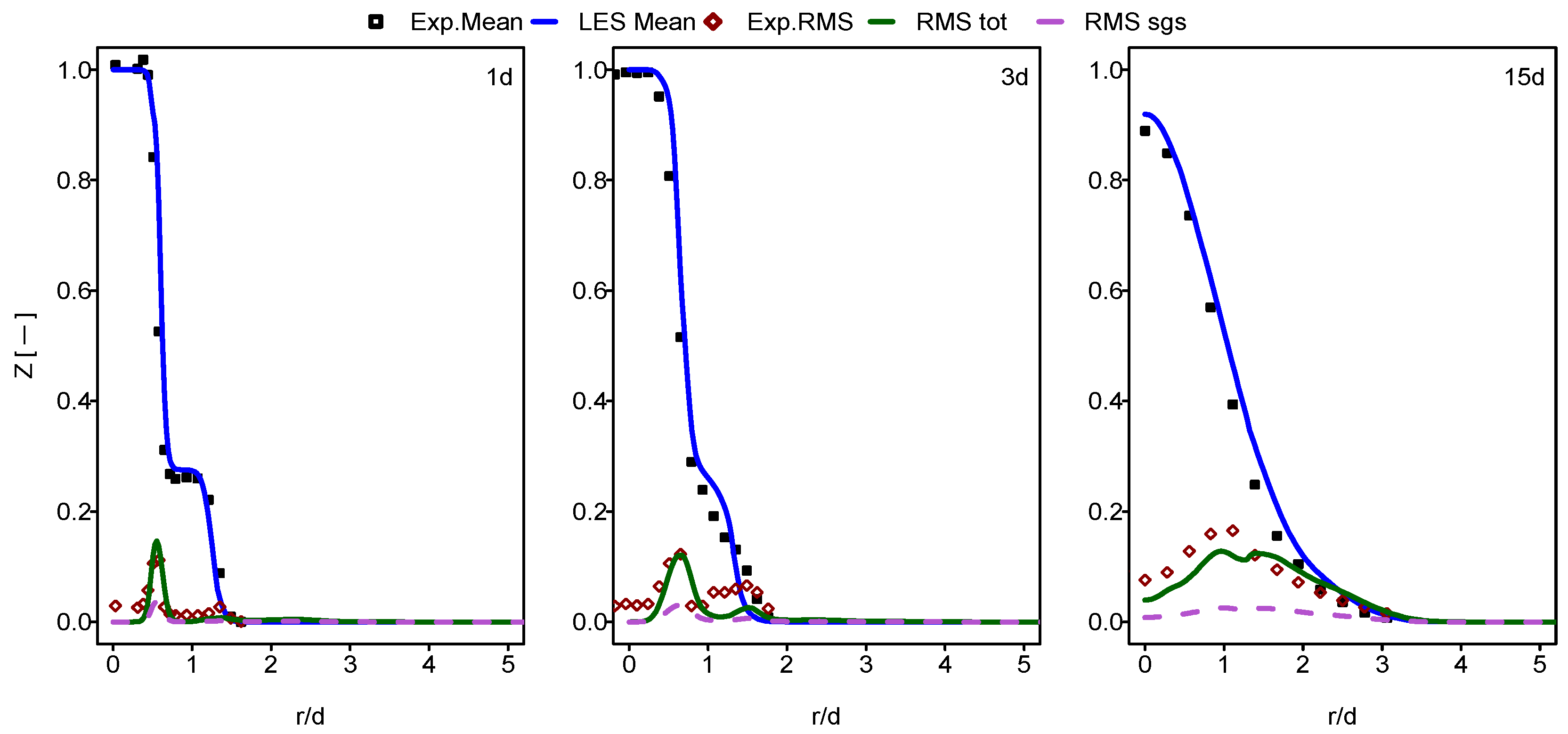
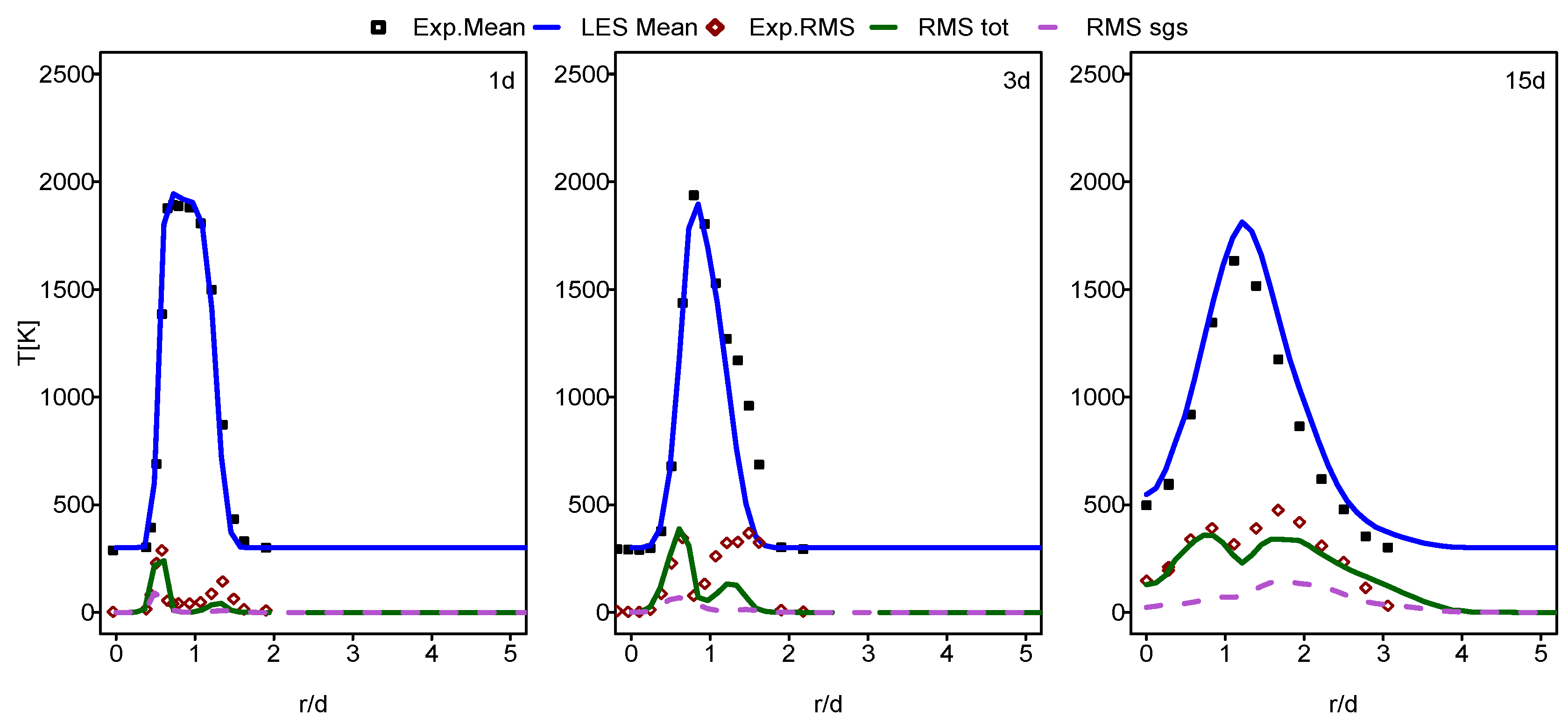
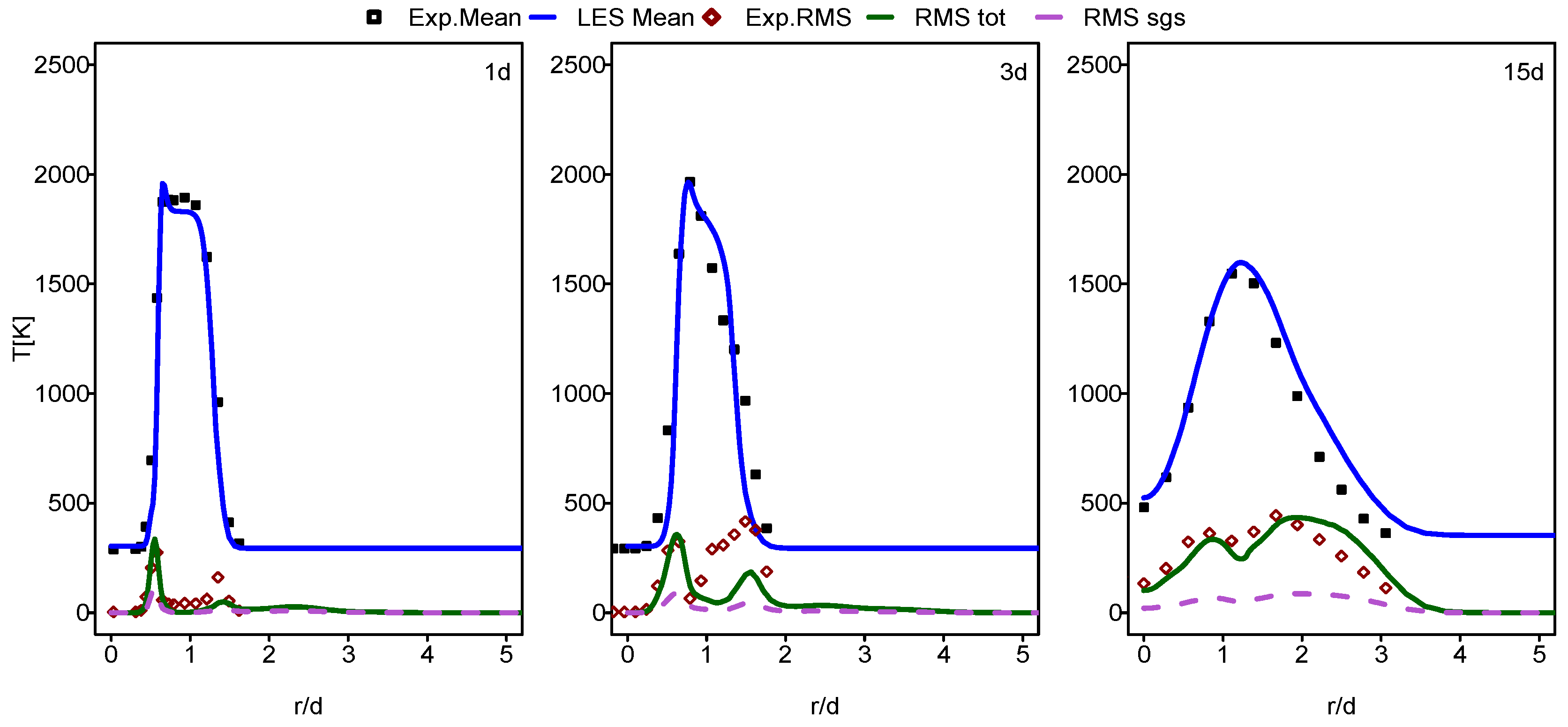


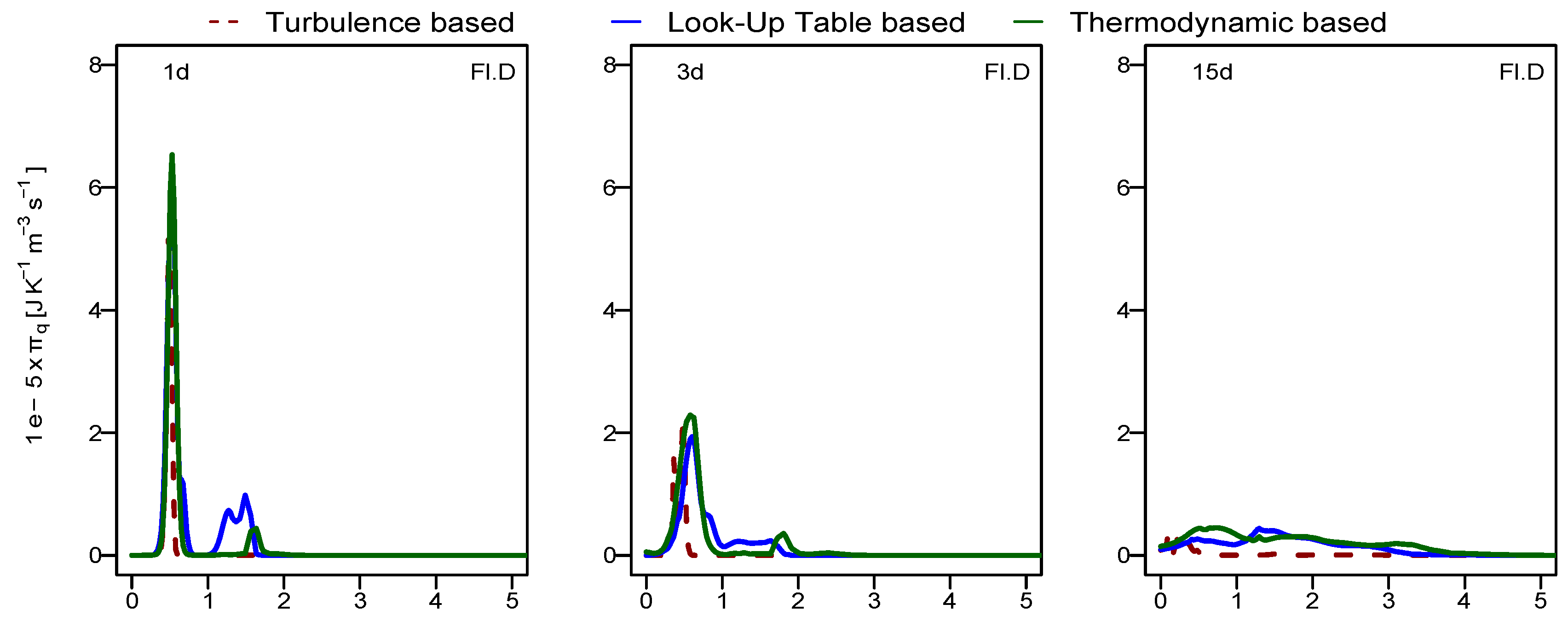
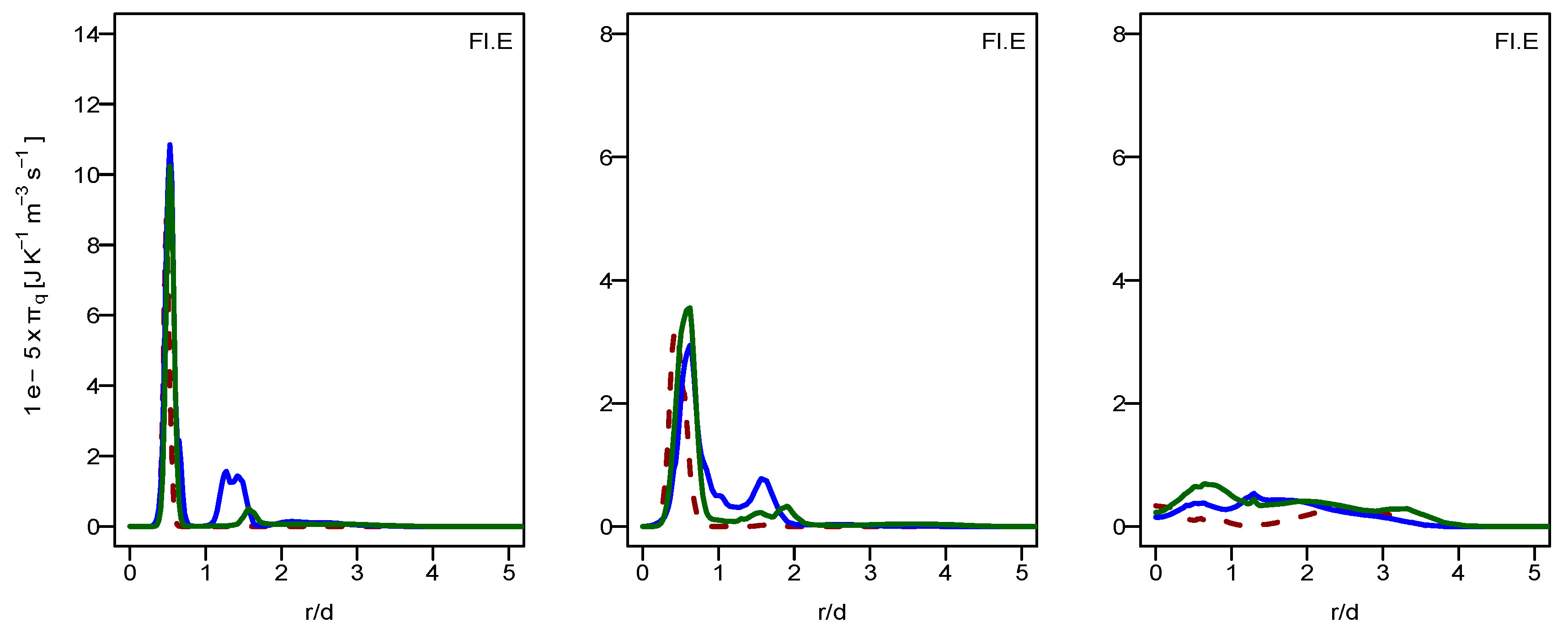
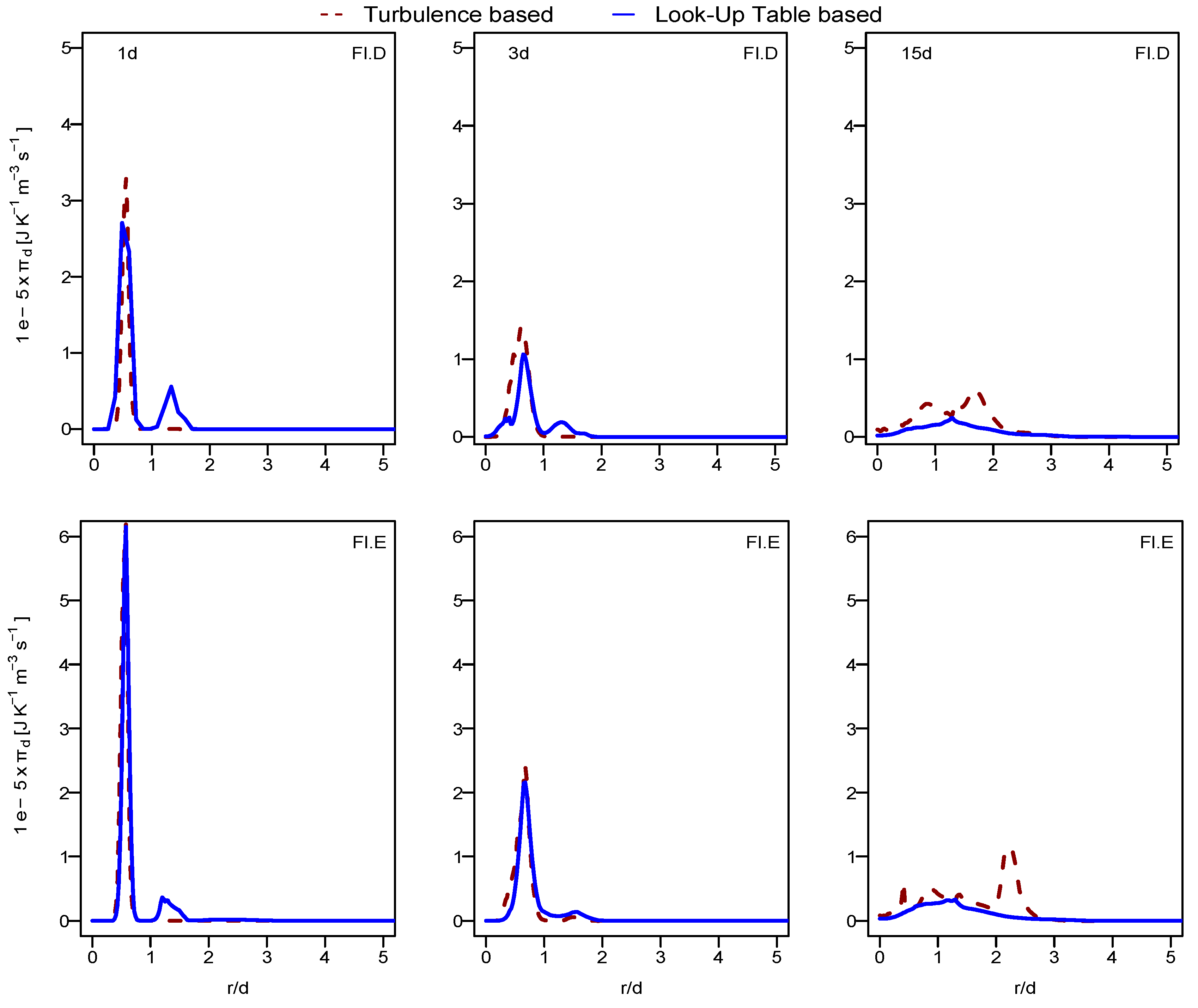
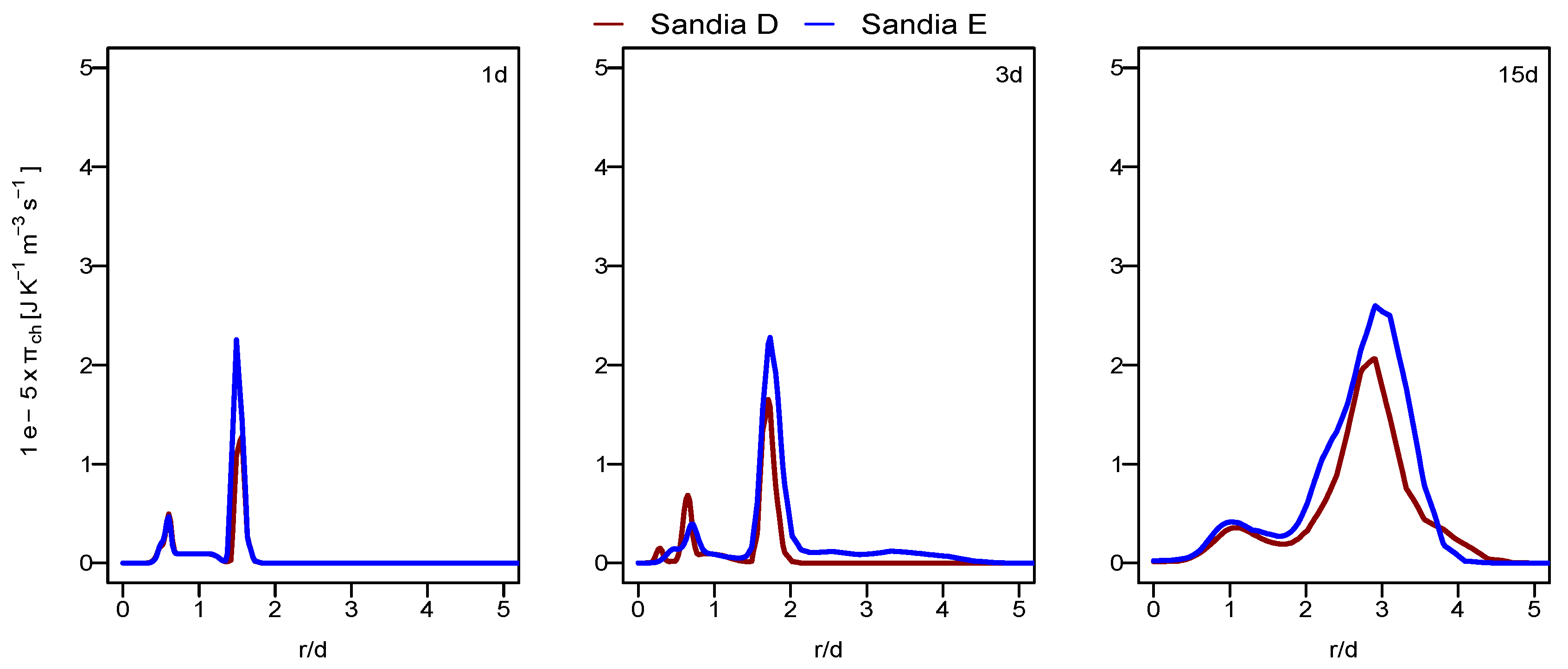
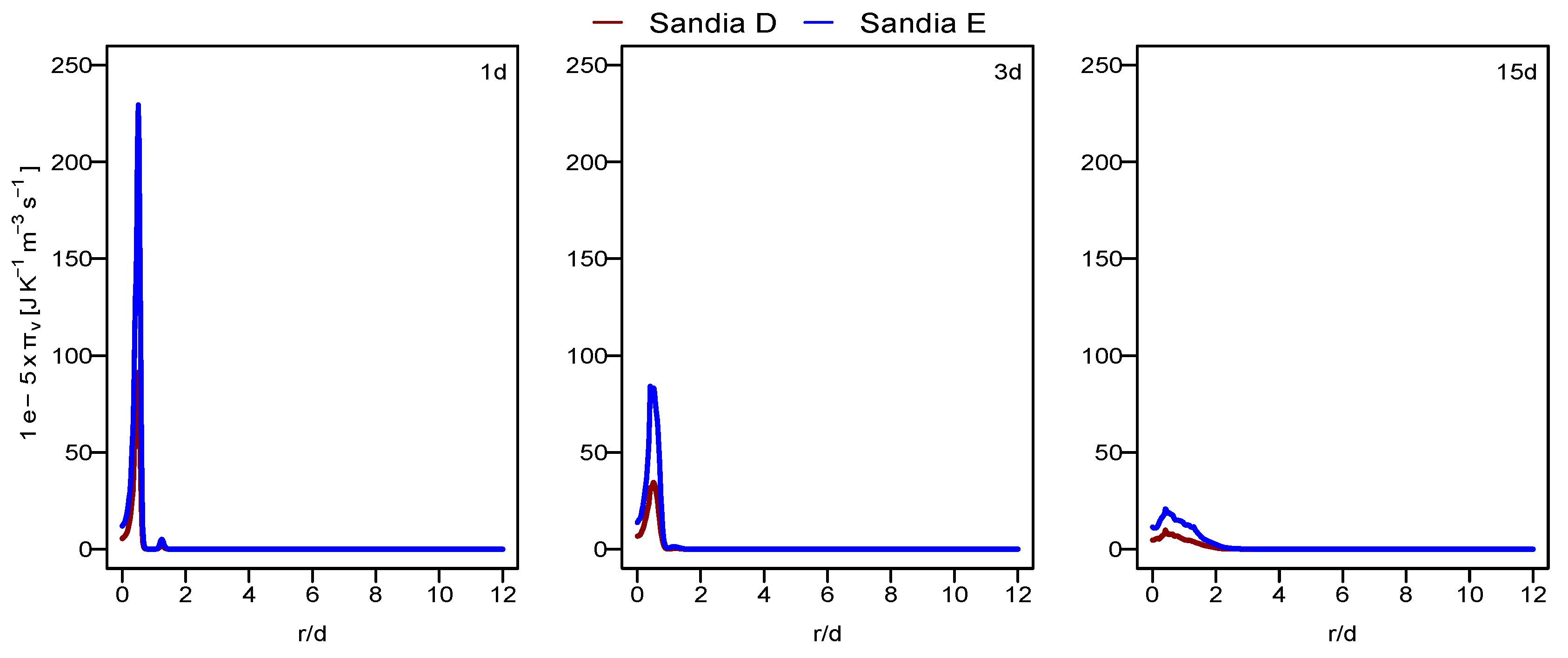


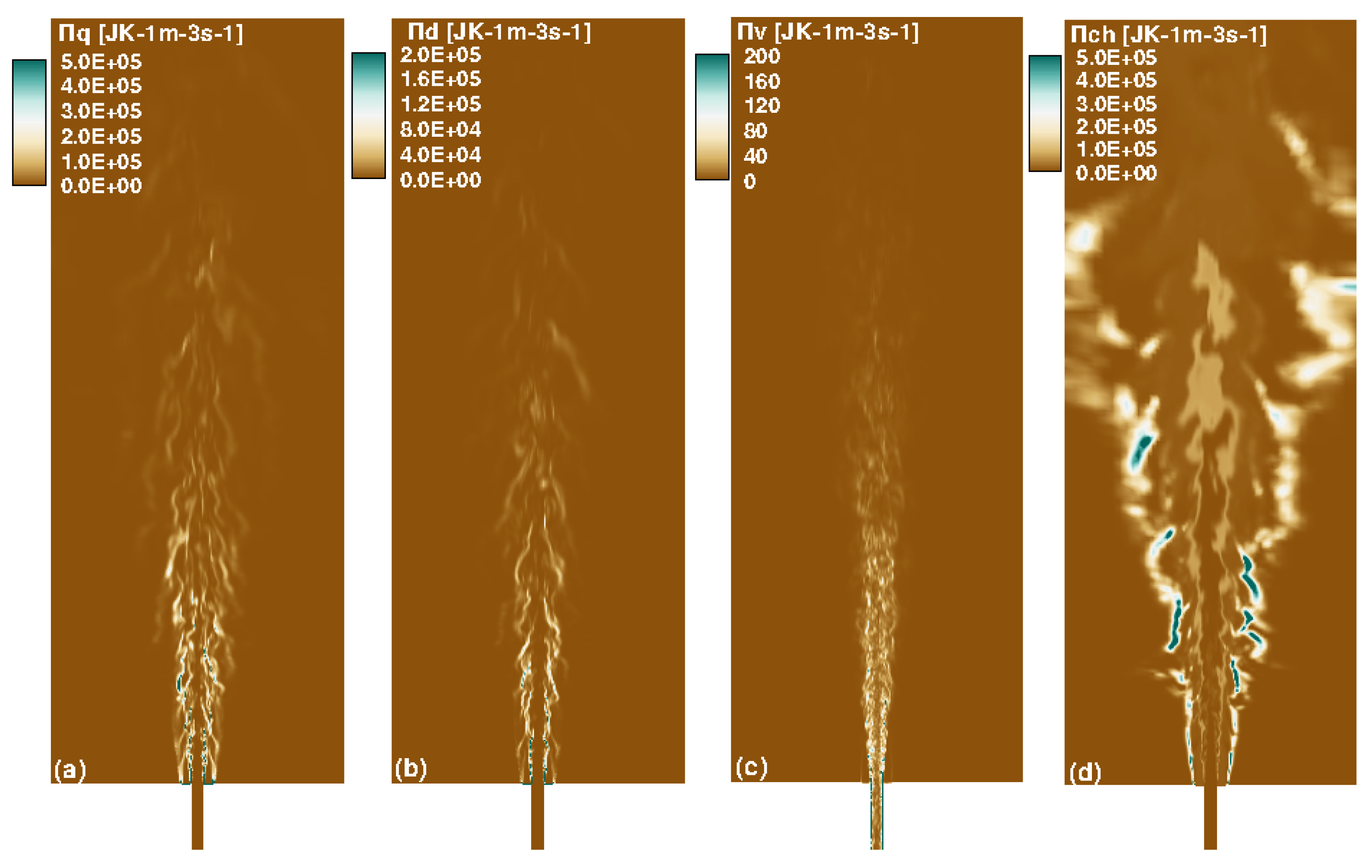
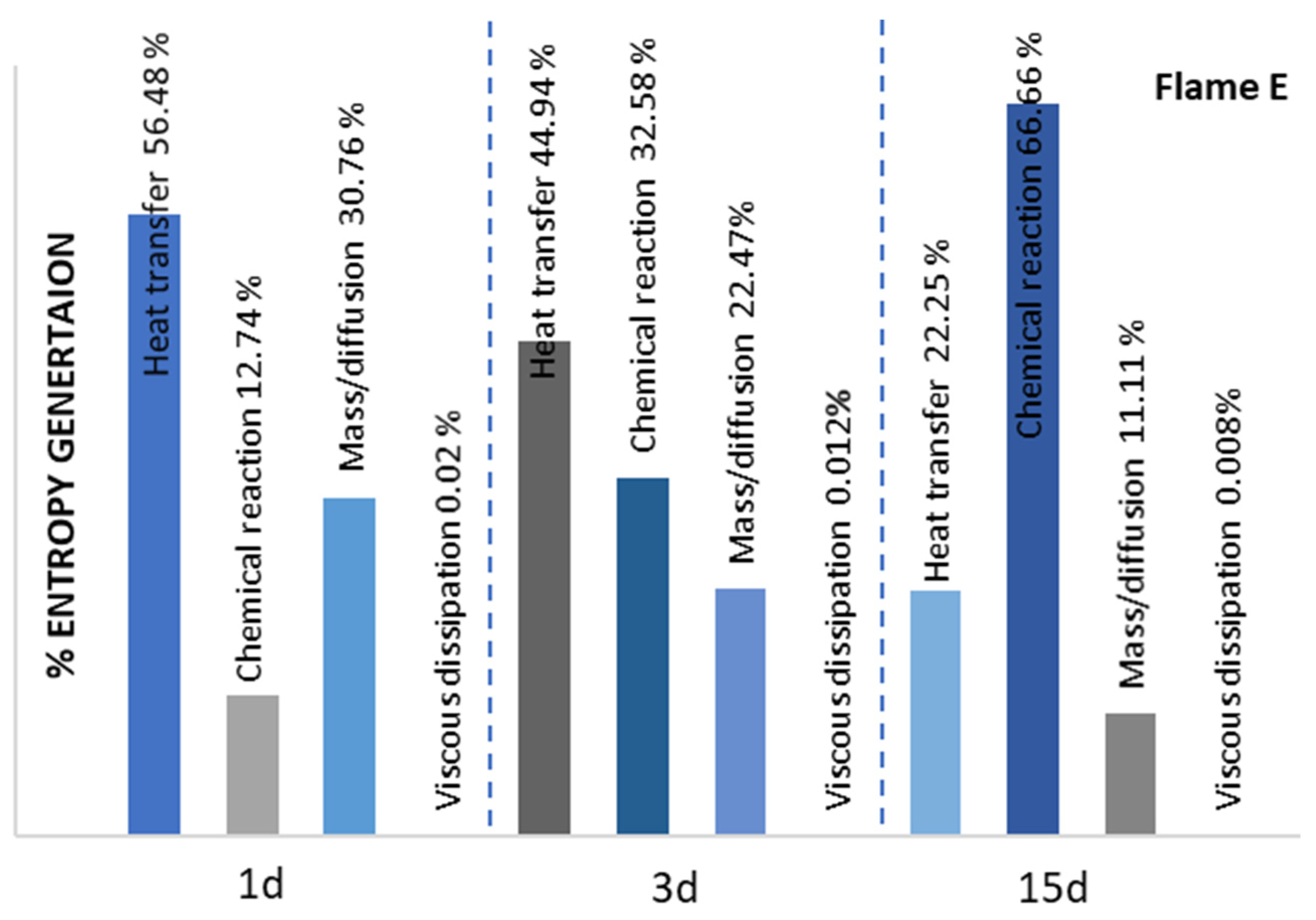
Publisher’s Note: MDPI stays neutral with regard to jurisdictional claims in published maps and institutional affiliations. |
© 2021 by the authors. Licensee MDPI, Basel, Switzerland. This article is an open access article distributed under the terms and conditions of the Creative Commons Attribution (CC BY) license (https://creativecommons.org/licenses/by/4.0/).
Share and Cite
Agrebi, S.; Dreßler, L.; Nicolai, H.; Ries, F.; Nishad, K.; Sadiki, A. Analysis of Local Exergy Losses in Combustion Systems Using a Hybrid Filtered Eulerian Stochastic Field Coupled with Detailed Chemistry Tabulation: Cases of Flames D and E. Energies 2021, 14, 6315. https://doi.org/10.3390/en14196315
Agrebi S, Dreßler L, Nicolai H, Ries F, Nishad K, Sadiki A. Analysis of Local Exergy Losses in Combustion Systems Using a Hybrid Filtered Eulerian Stochastic Field Coupled with Detailed Chemistry Tabulation: Cases of Flames D and E. Energies. 2021; 14(19):6315. https://doi.org/10.3390/en14196315
Chicago/Turabian StyleAgrebi, Senda, Louis Dreßler, Hendrik Nicolai, Florian Ries, Kaushal Nishad, and Amsini Sadiki. 2021. "Analysis of Local Exergy Losses in Combustion Systems Using a Hybrid Filtered Eulerian Stochastic Field Coupled with Detailed Chemistry Tabulation: Cases of Flames D and E" Energies 14, no. 19: 6315. https://doi.org/10.3390/en14196315
APA StyleAgrebi, S., Dreßler, L., Nicolai, H., Ries, F., Nishad, K., & Sadiki, A. (2021). Analysis of Local Exergy Losses in Combustion Systems Using a Hybrid Filtered Eulerian Stochastic Field Coupled with Detailed Chemistry Tabulation: Cases of Flames D and E. Energies, 14(19), 6315. https://doi.org/10.3390/en14196315






